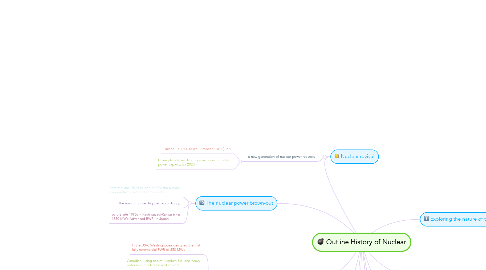
1. Developing the concepts
1.1. that almost every collision of a neutron with a U-235 atom would result in fission, and that both slow and fast neutrons would be equally effective
1.2. two summary reports
1.2.1. Use of Uranium for a Bomb
1.2.2. Use of Uranium as a Source of Power
2. The Manhattan Project
2.1. (1943) British handed over all of their reports to the Americans and in return received copies of General Groves' progress reports to the President
2.2. sufficient Pu-239 and highly enriched U-235 was produced by mid-1945.
3. The Soviet bomb
3.1. Research had three main aims:
3.1.1. to achieve a controlled chain reaction
3.1.2. to investigate methods of isotope separation
3.1.3. to look at designs for both enriched uranium and plutonium bombs
3.2. it was decided in late 1945 to begin construction of the first gaseous diffusion plant at Verkh-Neyvinsk
4. Revival of the 'nuclear boiler'
4.1. The first nuclear reactor to produce electricity (EBR-1) by Argonne National Laboratory
4.2. The main US effort was developed the Pressurised Water Reactor (PWR) for naval (particularly submarine) use.
5. Nuclear energy goes commercial
5.1. In the USA, Westinghouse designed the first fully commercial PWR of 250 MWe
5.2. Canadian, using natural uranium fuel and heavy water as a moderator and coolant.
5.3. France started out with a gas-graphite design
5.4. the first two Soviet nuclear power plants were commissioned
5.4.1. A 100 MW boiling water graphite channel reactor
5.4.2. a small (210 MW) pressurised water reactor (PWR)
5.5. In Kazakhstan (the BN-350)
6. The nuclear power brown-out
6.1. From the late 1970s to about 2002 the nuclear power industry suffered some decline
6.2. The uranium price dropped accordingly,
6.3. by the late 1990s - Kashiwazaki-Kariwa 6 - a 1350 MWe Advanced BWR, in Japan
7. Nuclear revival
7.1. a new generation of nuclear power reactors
7.1.1. Finland - a 1600 MWe European PWR (EPR)
7.1.2. China plans towards a huge increase in nuclear power capacity by 2020
8. Exploring the nature of the atom
8.1. Uranium
8.1.1. Klaproth
8.2. Ionising radiation
8.2.1. Rontgen
8.3. pitchblende
8.3.1. Becquerel
8.4. gamma rays
8.4.1. Villard
8.5. Meitner, Frisch, Bohr
8.5.1. Explore the atom
9. Harnessing nuclear fission
9.1. fission was much more likely to occur in the uranium-235 isotope than in U-238
9.2. fission would occur more effectively with slow-moving neutrons than with fast neutrons
9.3. U-235 was then known to comprise only 0.7% of natural uranium
10. Nuclear physics in Russia
10.1. early 1930s there were several research centres specialising in nuclear physics
10.2. By the end of the decade, there were cyclotrons installed at the Radium Institute and Leningrad FTI
11. Conceiving the atomic bomb
11.1. an amount of about 5kg of pure U-235 could make a very powerful atomic bomb (Frisch-Peierls Memorandum)
11.2. Two important developments came from the work at Cambridge
11.2.1. chain reaction could be sustained with slow neutrons in a mixture of uranium oxide and heavy water
11.2.2. When U-235 and U-238 absorb slow neutrons, the probability of fission in U-235 is much greater than in U-238.
